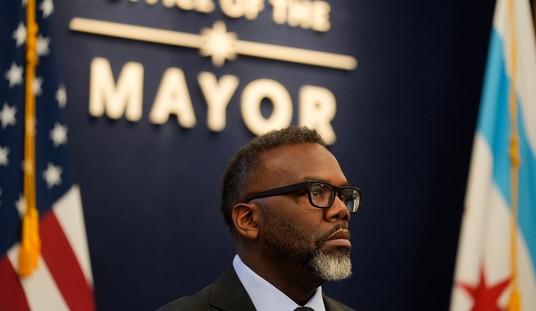Citing threats of violence, Ferguson Police Officer Darren Wilson, who fatally shot Michael Brown Aug. 9, resigned from the police department Saturday…
In a telephone interview Saturday evening, Wilson said he resigned after the police department told him it had received threats that violence would ensue if he remained an employee.
“I’m resigning of my own free will,” he said. “I’m not willing to let someone else get hurt because of me.”
He said resigning was “the hardest thing I’ve ever had to do.”
Just two hours after he gunned down unarmed teenager Michael Brown following, he has claimed, a struggle for his life, Darren Wilson showed ‘no apparent distress’ and scant physical injury…
The records describe Wilson as ‘Well appearing; well nourished; in no apparent distress.’
He head is ‘atraumatic.’ There is ‘no palpable pain, swelling, ecchymosis (bruising) or deformity’ to his eyes; ‘no obvious nasal injury’; ‘no swelling, deformity or crepitus (popping or cracking when moving)’ in his jaw which is shows only ‘mild ecchymosis (bruising), and mild to minimal palpable pain.
Despite claims that his neck was scratched and jarred in the tussle Wilson’s neck is described as ‘Supple and non-tender’ with only a ‘few faint superficial abrasions to posterior neck at hairline, no bleeding, no laceration and no bruising.
Darren Wilson failed to follow what is considered to be standard protocol after a shooting. And he was hardly the only one. The transcripts from grand jury testimony make evident that police carried out numerous actions that experts say are highly unusual. First of all, Wilson drove himself back to the police station, put his own gun into evidence and quickly washed blood off his hands without anyone photographing them first, reports the Washington Post. Apparently “there was no photographer available” and Wilson seemed to be more concerned with getting someone else’s blood off his body than preserving evidence. “His concern was not of evidence, but as a biohazard or what possible blood hazards it might attract,” said an FBI agent.
A former Florida police chief tells the Post that Wilson’s actions, particularly handling his own weapon and washing his hands, were “totally unorthodox and unusual” adding that “this would be considered very out of line—very, very bad from an investigative perspective.”
Others also moved forward in a way that several experts described as unusual. The officers who interviewed Wilson after the shooting did not record the conversation, for example. And the medical examiner did not take photographs—because his camera’s battery was dead—nor measurements at the scene of the crime—because what had happened was “self-explanatory.”
Wilson also testified that even after being shot and wounded several times, Brown continued to “charge” at him, with an intent to kill. “When he stopped, he turned, looked at me, made like a grunting noise and had the most intense, aggressive face I’ve ever seen on a person. When he looked at me, he then did like the hop … you know, like people do to start running,” Wilson testified.
It’s hard to fathom what is more absurd, the idea that a multiple gunshot wound victim would keep coming for more, or that a grand jury would believe it.
I’ve never been accosted by the police, which makes me something of a statistical oddity. I assume however that if I ever am, I would be terrified and I certainly wouldn’t attack an armed officer. I’m not a coward. It’s just that I just don’t have a death wish. And, contrary to some peoples’ opinions, neither do the overwhelming majority of African-Americans.
This is why it’s hard for many to understand Wilson’s story. Basic common sense tells us that if someone has a gun and you don’t, you don’t pick a fight with them and you certainly don’t run at them full speed with your arms out while being fired on. Brown tested positive for marijuana, but not for a drug that historically associated with aggressive behavior like PCP. Nothing in his history supports the notion that he was prone to sudden, heedless violence.
“He’s had to learn to live in a way that makes him completely unnoticeable. As a consequence, there are several techniques that he utilizes that make that happen,” Bruntrager said without elaborating. “It’s an odd way to live your life. But for him, it’s all about his family.”…
His lawyers said his story has remained the same throughout.
“I met Darren Wilson approximately one hour after the incident,” his attorney, Greg Kleoppel, told CNN. “That statement has been consistent one hour after the shooting, the following interview with the St. Louis County detective and on August 10 when it was recorded at the St. Louis County Police Department.”
“Hands Up. Don’t Shoot!” became a rallying cry for protesters in the streets of this St. Louis suburb and a symbol nationwide of racial inequality for those who believe that minorities are too often the targets of overzealous police.
Yet the witness accounts contained in thousands of pages of grand jury documents reviewed by The Associated Press show many variations about whether Brown’s hands were actually raised – and if so, how high…
Some witnesses said the 18-year-old had his hands held high toward the sky as Ferguson Police Officer Darren Wilson gunned him down midday Aug. 9. Others thought they saw his hands partially raised, about shoulder high. To some witnesses, his palms appeared out, as if surrendering. To others, his palms seemed open, as if glancing at his wounded hand or gesturing with an attitude of “what are you going to do about it.” Some said Brown’s hands weren’t raised at all…
Several demonstrators said focusing on the exact circumstances of Brown’s shooting misses the point of the slogan.
An anonymous woman who gathered nearly 200,000 Facebook supporters for Ferguson police officer Darren Wilson says backers raised more than $500,000 for his defense.
The money collected on behalf of the officer since the fatal Aug. 9 shooting of 18-year-old Michael Brown Jr. could possibly swell to double that amount, the woman told MailOnline.com…
The unidentified woman launched her own Facebook campaign quickly after the shooting, selling T-shirts with the words “I am Darren Wilson” and wristbands with his name. She runs a pair of pro-Wilson Facebook sites that have collected tens of thousands of backers, but she declined to give her name, indicating her support of Wilson made her a target of vile Internet threats.
Progressives mocked the bruises on Wilson’s face but haven’t gone so far as to deny he was punched at all. Even that admission is a problem for them since Brown’s friend (and the left’s favorite witness) Dorian Johnson has repeatedly claimed Brown’s hands were never in the car at all. In an interview with MSNBC’s Chris Hayes Tuesday, Johnson once again repeated this claim. Hayes is clearly aware of the contradiction with the evidence and briefly confronts Johnson with it before he backs off. But the obvious question–Where did the bruises on Wilson’s face come from?–doesn’t get asked…
While ignoring the false and contradictory witness statements, progressive outlets eagerly competed to suggest Wilson was lying about what happened. Vox’s Ezra Klein wrote a piece based around the claim that Officer Wilson’s story as presented to the grand jury was just not credible. As evidence for this claim, Klein singled out a moment in Wilson’s grand jury testimony which he said was just not something a human would do. As Klein colorfully put it, “Every bullshit detector in me went off when I read that passage.”
The moment in question was the one when, in the midst of the fight with Wilson, Brown turned to his friend Dorian Johnson and handed off the stolen cigarillos. What Klein didn’t point out was that Brown’s friend had told the grand jury the same story. Klein’s piece was the top story on Vox all day. Tens of thousands of people shared it on Twitter and on Facebook. But just like ABC News during the Martin case, Klein chose not to publish a correction. Instead he wrote a new piece admitting (several hundred words in) he had been wrong. He added an anodyne link at the bottom of the original post such that people who only read the first piece still don’t know Klein’s central contention is in error…
There are real world consequences to the behavior by the progressive media. Early, incomplete reporting leaves behind an understandable residue of anger. Irresponsible attacks on the process based on feelings, BS detectors and misreadings of evidence (or ignoring evidence altogether) further stoke that anger. The real fires we see burning in Ferguson aren’t that surprising given the story the progressive media has tried to tell about this case. Even after those fires go out the damage will remain.
At a proper trial, Wilson could not have been convicted of murder. That does not mean what happened was not horrible — it was. It does not mean Wilson is not civilly liable (although I doubt that he is). It simply means the circumstances of the shooting do not meet the high criminal-law standards for either intentional homicide or the criminally irresponsible causing of death.
The critics’ claim that Wilson’s innocence is put in doubt by “conflicting testimony” is legally and factually frivolous. Legally, our system resolves all doubt in favor of the accused — as the Left is apt to remind us when a terrorist is in the dock, this is called the “presumption of innocence.” Factually, the chatter about “conflicting testimony” falsely implies that all testimony is created equal. In reality, accounts given by anti-Wilson witnesses, where not patently fabricated, tended to be discredited by forensic evidence. The forensics, instead, corroborated the exculpatory testimony — much of which came from African-American witnesses, a fact that undermines the myth and therefore goes largely unnoticed. The grand-jury rules are more permissive than those that govern criminal trials, but prosecutors are still ethically barred from asking the grand jury to rely on testimony they believe is false, inaccurate, or unconvincing.
Add to that the facts that Wilson’s own testimony would have powerfully influenced a jury (as a credible defendant’s testimony always does), and that Wilson would have had the benefit of Missouri law, which looks favorably on the use of deadly force by police officers who are endangered in attempting to make an arrest. A jury would have acquitted Wilson in short order — assuming for argument’s sake that the judge had not dismissed the case for lack of evidence before letting it get to jury deliberations.
If the Michael Brown shooting were an ordinary case, a grand jury would never have been asked to consider indicting Officer Wilson. McCulloch, the chief prosecutor, directed his office to present it to the grand jury because it was not an ordinary case — because it was a racially charged case in which Al Sharpton’s notorious “No Justice, No Peace” demagoguery was amplified by the community organizers in the White House and the most politicized Justice Department in American history.








Join the conversation as a VIP Member